Wildebeest, Maasai, and elephants. Try an unconventional safari
A white father-and-son duo of American safari aficionados shares their exhilarating African safari experience
By Professor Jeff Fadiman Images by Paul Ole Leitura
Tanzania has more wild animals per square mile than any place on earth. Four million animals fill 32 wildlife reserves, including 3,000 lions. 1592 safari firms have been formed to show these millions to the tourists. All of them hunt for Africa’s Big Five. Unfortunately, almost all of them follow the same route, moving through the parks in a continuous line. Thus, thousands of tourists see the same herds, probably the same animals and surely the same lions.
My son and I created an unconventional safari. We focused on three species most tourists ignore: Wildebeest, elephant, and the Africans themselves. We started on the most dramatic moment in a wildebeest’s life: its leap into a flowing river filled with 300 crocodiles.
Life as a wildebeest
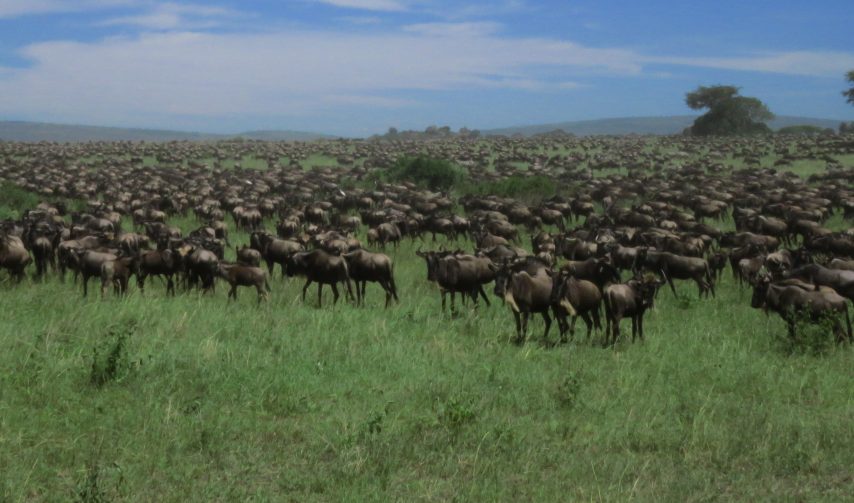
A wildebeest is funny-looking: long head, small horns, tiny eyes, huge nose and white beard that actually hangs from its neck. It is hump-backed, has sloping hindquarters and spindly legs. Its head bobs endlessly up and down as it walks—and it walks all its life. Worse, it half-moos-half croaks. To hear one of these is not bad; but wildebeests move in herds that stretch from horizon to horizon. To drive all day with the moving, mooing herds is to go privately insane.
For thousands of years, 1,300,000 wildebeests have migrated north to south to north again—up and down the Serengeti plain. This gigantic, moving mass is joined by 300,000 zebras, 2,500 antelopes, plus lions, leopards, hyenas, jackals, vultures, buzzards and every other predator. They are also followed—in the daytime—by predatory land cruisers, each filled with camera-mad tourists filming what could be called the greatest show on earth.
Wildebeests are smart—enough to ensure survival. Each January, they gather in their thousands at a single point—to give mass birth. Some 500,000 wildebeest calves are born over three weeks, averaging 24,000 per day. Calves stand within seven minutes. They run within one day.
The moment of birth determines whether a new-born calf will survive its first day. Wildebeests give birth in daylight. Lions, leopards, and hyenas hunt at night. Thus, a calf born at 9 a.m. has 7-8 hours to get moving, running beside his mother to escape predators. A calf born at dusk has less time to learn and is often eaten on its first day.
The Great Trek
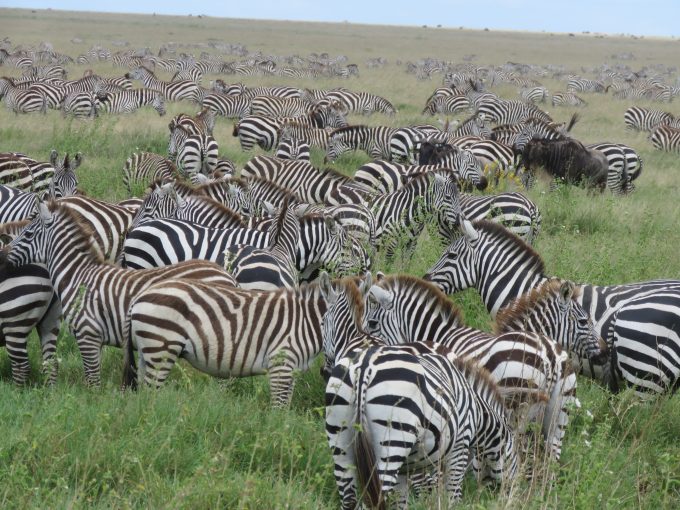
With the birthing complete, the entire herd starts its migration. Wildebeests are hungry—always hungry—especially the females. Thus, each must eat continuously. Since constant grazing eliminates the grass, the herd must always move. It does this by following the rain clouds, perhaps drawn by the scent of rainwater. After the great birthing, the clouds move north, raining on the plain. New grass grows. The herd grazes, with the zebras and antelopes devouring slightly different grasses. Once on migration, the horde splits into uncountable numbers of single, straight lines, all moving north. Once in a line, each animal follows nose-to-tail, every head nodding up and down as they press on.
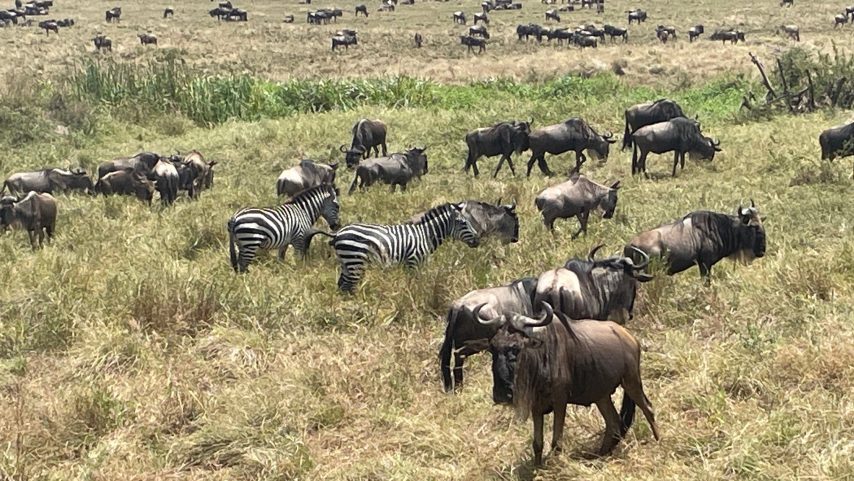
It is only after watching the migration that the body parts of single wildebeests make sense. The little horns don’t weigh much and are thus easy to carry in a lifetime of walking. The huge, flat muzzle acts as a lawnmower. The sloping back and spindly legs let it run 50 miles an hour. Lion-researchers estimate that their attacks on wildebeest fail 75% of the time.
The moving lines spread dung across the plains, thus fertilizing the soil. If Serengeti’s grasses benefit, the grazer population expands, as does that of butterflies, pangolins, dung beetles—and predators. Is it the dung from1,300,000 migrating grazers that brings Serengeti to life?
Crossing the Crocodile River
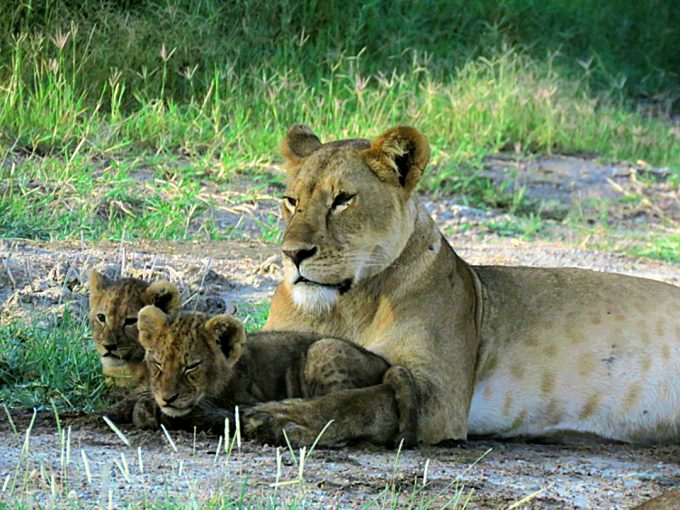
We drove north for hours, placidly passing the lines of plodding migrants. Then, we reached the Mara River, bordering Tanzania and Kenya. We could see the water shining, as well as a few of the river’s 300 crocodiles, sleeping on the riverbanks waiting for dinner.
Our tourist itinerary called for all 1,300,000 wildebeests to leap joyfully off the small riverbank cliffs, and swim cross, avoiding the crocs, who were gobbling the injured, old and young. They were then to lunge up the opposite bank, dodge the lions and hyenas waiting on top, and continue their migration into the Kenya grass lands.
Our problem: No one was crossing. The migrants stood still, grazing in long lines and huge herds. Zebras, gazelles and land cruisers littered the landscape. We waited. Nothing moved. One hour. Two hours. Sometimes a line of wildebeests approached the water. Instantly, land cruisers would snake towards their crossing point, settling in clumps at both ends. The wildebeests responded by stopping to graze. No hoof touched water. Their lines grew longer. The herds piled up. The sun went lower. No crossings.
We sighed collectively and left, cutting slowly through an enormous herd to reach a road. Suddenly, we were in the midst of 100,000 wildebeests. We cut the motor, stood silent and still, smelled the herd, and listened to 100,000 croaking moos. Privately, I felt a deep peace. Human life is simply better when our world is filled with animals.
We reached the road. Our radio crackled. “They are crossing at point three!” We whirled around and raced for point three. Nothing! The radio crackled, “Not point three. Point four. I mixed the numbers.” Off to point four. Nothing. By this time the radio was having a wonderful time. “Point three. Point eight. Point one.” We raced around. No crossings. We went home. Later, we learned that they crossed just after sundown, when every driver had left the river to feed the tourists dinner.
Will Tanzania destroy its primary tourist attraction? Will the number of land cruisers grow until they block the crossings completely? Will the wildebeest learn not to cross, and simply stand and graze? Time will tell. At this moment, the chances of watching a million animals swim a crocodile-filled river are very low.
The Maasai: Return to the warrior past

Most tourists visit Tanzania only to see animals. Few visit Maasai communities. Those who do stay ten minutes to buy beads, then leave having said nothing more than “thank you.” We wanted to spend time with Maasai and talk.
In the old days, Maasai lived communally, in mud and cow-dung huts drawn together in a single protective circle (a manyatta). The huts were surrounded by thornbush, piled eight feet high to keep out lions. Maasai cattle spent nights in the manyatta’s center. People lived along the rim. Every warrior carried a seven-foot spear, with a 12-inch iron head. They dyed their long hair bright red (with clay), wore only a red blanket and walked barefoot…
These days Maasai still hold tightly to their communal traditions. However, the modern world has not only intruded but badly hurt some of their communities. One group has lived, for decades, inside the world-famed Ngorongoro, a volcanic crater set aside for wildlife and tourists. Over time, however, both the Maasai and their cattle increased—threatening the grasses wildlife need to survive.
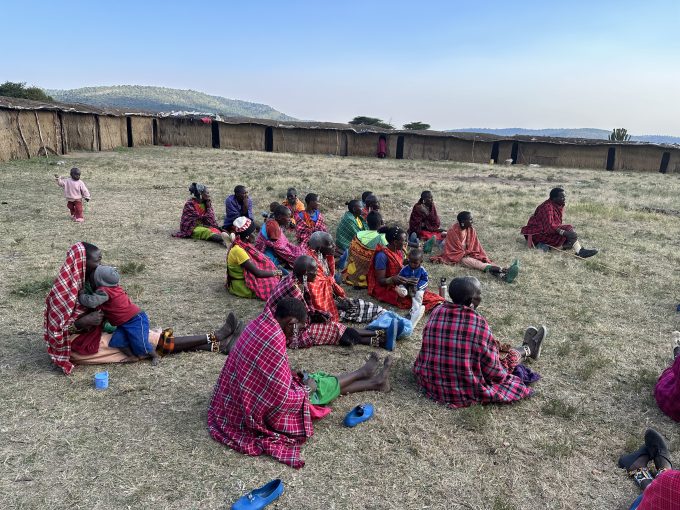
In June 2022, the Tanzanian Government decided to evict Maasai and cattle alike from the crater, leasing the land to an Arab Royal family for unrestricted hunting. Maasai witnesses suggest that the Royal Arabs hunt from racing trucks with sub-machine guns, killing everything that moves.
At dawn, the community woke to find itself surrounded by 200 armed police. The officers ordered everyone to leave both their homes and cattle and be trucked outside the crater. Livid at being deprived of their cows, the warriors fought back with bows and arrows. The police replied with rifles. There were deaths on both sides.
The community now lives on flat grassland on the edge of Serengeti. Although deprived of their cattle, they are not starving. Nonetheless, there is no milk for their babies and no fees to pay for school.
However, there is hope. To earn money, they have decided to retreat into the Maasai warrior past, in hope of drawing tourists. They call the project “Maasai Land, 1895.”
It will begin by reconstructing their traditional manyatta as it was in 1895. The many homes within the circle will be constructed of mud and cow-dung as tradition demands. The people will become actors, wearing both the red-clay hairstyles and red blankets worn in the past. Young men will carry the traditional spears. Older women will recreate the traditional bead-ornaments. When tourists arrive, they will be greeted in Maasai language, then seated in the manyatta. The girls will dance. Then, the warriors will compete in jump-dancing, in which they stand at attention then leap into the air using only their ankles.
Thereafter, two warriors with spears will demonstrate the traditional fighting tactics in war. Then, cows will be displayed, to demonstrate the art of milking. Finally, the women will bring out their most beautiful, beadwork—artfully displayed—while a narrator suggests two reasons to buy:
- The beadwork is beautiful.
- The money will buy milk for babies and school for kids.
It is unusual for American tourists to visit an African community that has been both badly damaged and bouncing back. By recreating their warrior past, they see a chance to build a future.
Elephant in camp

Our last adventure was imposed on us. It was all the elephant’s fault. We had gone to a wildlife reserve holding 2,500 elephants. Our hope was to drive the Landcruiser slowly through the great herds we had read of in stories of the African past. That didn’t happen. No great herds existed. Perhaps, they disappeared 100 years ago.
Instead, we saw elephant families of 8-12, but we saw them all the time. We spent a peaceful day following families, marveling at the tusks and smiling as the babies timidly approached our Landcruiser, trunks held high to catch our scent.
Experts say that elephants are telepathic. Elephant families seem capable of communicating with adjacent herds by ultrasonic signals that can be felt (but not heard) more than six miles away.
Humans are said to feel a gentle throbbing in the air, barely noticed if you drive between two elephant families (as we did all day), but easy to feel if you stand in total silence between two elephants who face one another. Our driver, who leads elephant-walking safaris, told us he often felt the air move as he stood between two elephants. We tourists, of course, heard nothing whatsoever.
Then we camped, in a registered campsite—all quite safe. We lit a fire, ate and slept. I woke hours later, because the tent was shaking—just a little. It would shake and stop. then shake again. Silently, I opened the tent flap. The view was blocked by an elephant leg.
The elephant stood just in front of our tent, peacefully eating adjacent bushes. As it munched, its trunk drifted back and forth brushing our tent rope. That sporadic movement was what woke me. The fire had gone out, and with it, our protection. Our driver was in another tent. No help there. To call out might startle the elephant into stomping the tent.
I jerked back onto my sleeping bag in mindless panic. My first reaction was ridiculous. I drew my hunting knife in my own defense, probably thinking I could stick the elephant’s foot if it stepped on my chest.
My second defense was total silence. If I woke my son up, he might talk—or even shout. That might scare the elephant, who might decide to stomp the tent. So, I simply lay fearfully on my sleeping bag all night. My son was asleep. The guide was asleep. They dreamed in sweet peace, and I hated them both.
The sun rose. The elephant moved 40 feet away. My son woke up, stretched and said: “Hi Dad, how did you sleep?”
To read more safari stories by Professor Jeff Fadiman, click below

